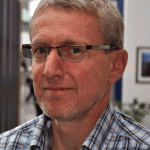About myself
 I am a human geographer. My research has primarily centred on two different themes: rural and regional development, and nature-culture relations. Have written about nature conservation, introduced species, and human-animal relations, for example. In recent years I have been preoccupied with energy research, especially the politics of landscape in the transition to renewable energy. I am right now collaborating with Czech researchers on an urban mobilites research, notably on 'two-wheeled transport' in the urban environment. Cycling is an important component of sustainable transport, and we are trying to find out what encourages or discourages the use of cycles for everyday travel. I am also starting work in Freetown, Sierra Leone, on urban energy challenges.
I am a human geographer. My research has primarily centred on two different themes: rural and regional development, and nature-culture relations. Have written about nature conservation, introduced species, and human-animal relations, for example. In recent years I have been preoccupied with energy research, especially the politics of landscape in the transition to renewable energy. I am right now collaborating with Czech researchers on an urban mobilites research, notably on 'two-wheeled transport' in the urban environment. Cycling is an important component of sustainable transport, and we are trying to find out what encourages or discourages the use of cycles for everyday travel. I am also starting work in Freetown, Sierra Leone, on urban energy challenges.
University studies
- BS in Geography from the University of Iceland, 1987.
- MA in Geography from the University of Auckland, 1990.
- PhD in Human Geography from the Australian National University, 1997.
Distinction:
- University of Auckland – Cumberland Prize 1990
Scholarships:
- Australian National University PhD-Scholarship, 1993-1997
- Overseas Postgraduate Research Scholarship (Australia), 1993-1997
Teaching
- Professor at the University of Iceland from 2006
- Senior Lecturer at the University of Iceland 2002–2006
- ERASMUS teaching exchange at Universitat Autònoma de Barcelona (1999) and Università degli studi "Gabriele d'Annunzio" Chieti Pescara (2009)
- Taught in doctoral courses at the University of Oslo (1997), University of Tromsø (2004), University of Stockholm (2008) and Swedish Agricultural University (2010)
- Lecturer at the University of Iceland 1997–2002
- Tutoring in human geography at the Australian National University, 1996
- Teaching full-time at the University of Iceland, 1991–1993
- Teaching part-time at the University of Iceland, 1990
- Tutoring in human geography at the University of Auckland, 1989
- Tutoring at the University of Iceland, 1987
